[Special Interview] Stephen D. Bloom (CEO of the Portland Japanese Garden) x Tomoki Kato x Yamaguchi
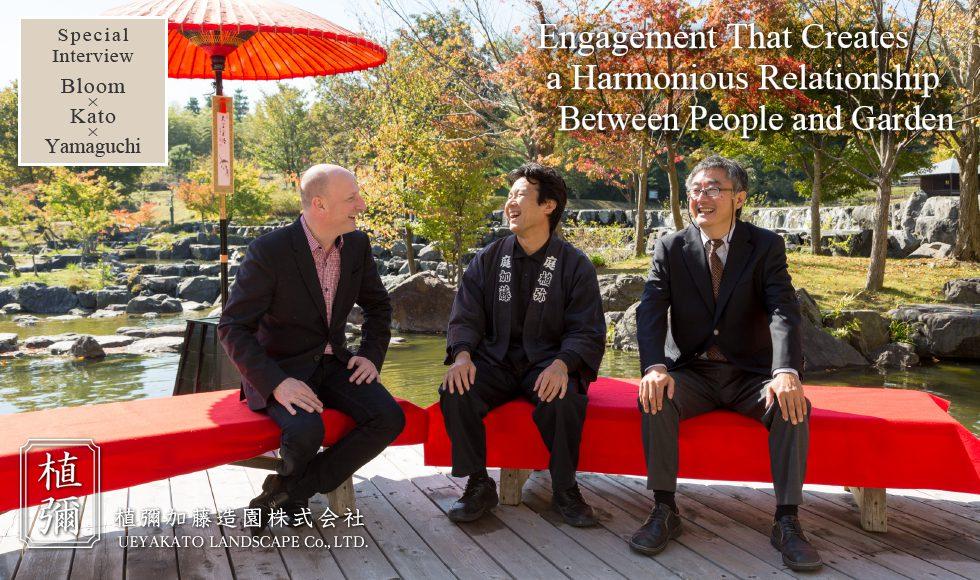
On October 16, 2015 (Friday), the Cooperative Agreement of Mutual Exchange was signed between the Portland Japanese Garden (Oregon, USA) and Ueyakato Landscape Co., Ltd., designated by Kyoto Prefecture to manage and operate the Keihanna Commemorative Park, to contribute towards the international development of Japanese garden culture. Mr. Stephen D. Bloom, CEO of the Portland Japanese Garden attended the signing event and afterwards, discussed with Tomoki Kato, our company president, and director Takashi Yamaguchi of the Keihanna Commemorative Park about information on exchange of reciprocal activities, potential future exchanges, and visions about Japanese gardens.
Participation Type Programming Triple Park Visitors
Kato Thank you for coming all this way today. It is an honor to be able to sign this Cooperative Agreement. Now as a stronger team, we can assist each other to flourish.
Bloom Since our first meeting in January 2013, we have cultivated our relationship where even our staff have become friends. Realizing that we are also a very good match on a professional level, this signing seemed to be the next logical next step. We are very honored and humbled to have this kind of relationship in Kyoto, a known mecca for Japanese gardens. We, the Portland Japanese Garden*1 are just starting-out in terms of garden history and techniques. We hope to learn much from our seniors in Kyoto and Japan.
Kato In terms of the technical side, we may be your seniors, but I believe the Portland Japanese Garden is our senior in management of park usage. In 2014 when you came to Japan and conducted the discussion study session at our office, you mentioned the key points of success for the Portland Japanese Garden*2, from which we greatly learned. I was especially impressed by one of your points, which was the change from a city funded park to a successful citizen funded non-profit organization (NPO) garden system. With about 8,000 members who pay an annual fee of $55 – 75 (USD) a year as of October 2015, creates a wonderful base of community support. I feel it reflects the community’s wish that you will continue to be a “wonderful Japanese garden.”
Bloom When I took the post in 2005, the first thing I did was to establish programming that would make the local community interested. I started by creating the job position, and assigning a personnel in charge of programming. Previously, there were no programming where the citizens could participate and experience the Japanese garden. Diane Durston was selected for this important role. She utilizes her 18-years of experience living in Kyoto and profound knowledge of Japanese culture and art into producing a variety of programs.
Kato What kind of programs for example?
Bloom From Hanami (flower viewing events) to Tsukimi (moon viewing events), to celebrating Kodomo-no-Hi (Children’s Day), as well as art exhibitions and workshops, and of course cultural classes on Kimono (traditional Japanese clothes), Ocha (Japanese tea ceremony), and Ohana (flower arrangement). We have a variety of annual events and a diverse programming of rich Japanese culture and art. What is most important is that the visitors are not just viewing these programs, but are able to participate and experience the programs. I learned from my experience while managing a symphony orchestra that “engagement” with the local communities and parties are most important when working for a NPO. First, it is necessary to be known, next to be of interest to the community, then through fun and enjoyable experiences you become important to them.
Kato What do you aim for in order to provide enjoyment to visitors and participants?
Bloom “Quality” and authentic “Japanese touch.” If we aim for programming where “everybody can enjoy,” then nobody will be highly satisfied at the end. It is necessary to arrange programs suitable for targeted age-range or public taste. In fact, many of our events are specifically catered to our targeted audience.
Kato I see, those efforts lead to many supportive fans. That is fantastic! The Portland Japanese garden’s current annual visitors are 350,000 people. I understand the number of visitors have tripled since you took the position.
Bloom Sometimes, too many visitors can become hard for the garden. However, I hope for more people to enjoy and love Japanese gardens. Currently, we are temporarily closed for about 5 months until we re-open in March 2016. This is necessary for our expansion project which will be completed by Spring 2017. There will be an addition of 7 gardens of various sizes and the International Institute (building) will be designed by Mr. Kengo Kuma, a world famous Japanese architect.
Kato What a large expansion! What are the highlights?
Bloom The characteristic of this plan is the harmonization of local materials such as trees and stones, with Japanese traditional skills and methods. There are a couple features that will be first of its kind in the USA. Such as the Anou-style stone wall made by a group of specialized Anou craftsman, another is the grass-roof made of new building materials. Both of these are attracting much attention from all directions of the world.
Kato That is definitely something to look forward to. The Portland Japanese Garden was designed in 1963, so the garden is around 50-years-old, however I feel the garden has aesthetically grown and aged much more than it actually has. It has some qualities that coincide with old gardens of Kyoto with histories of 100-years and 150-years. Therefore, the next 50-years and 100-years later will be exciting to see.
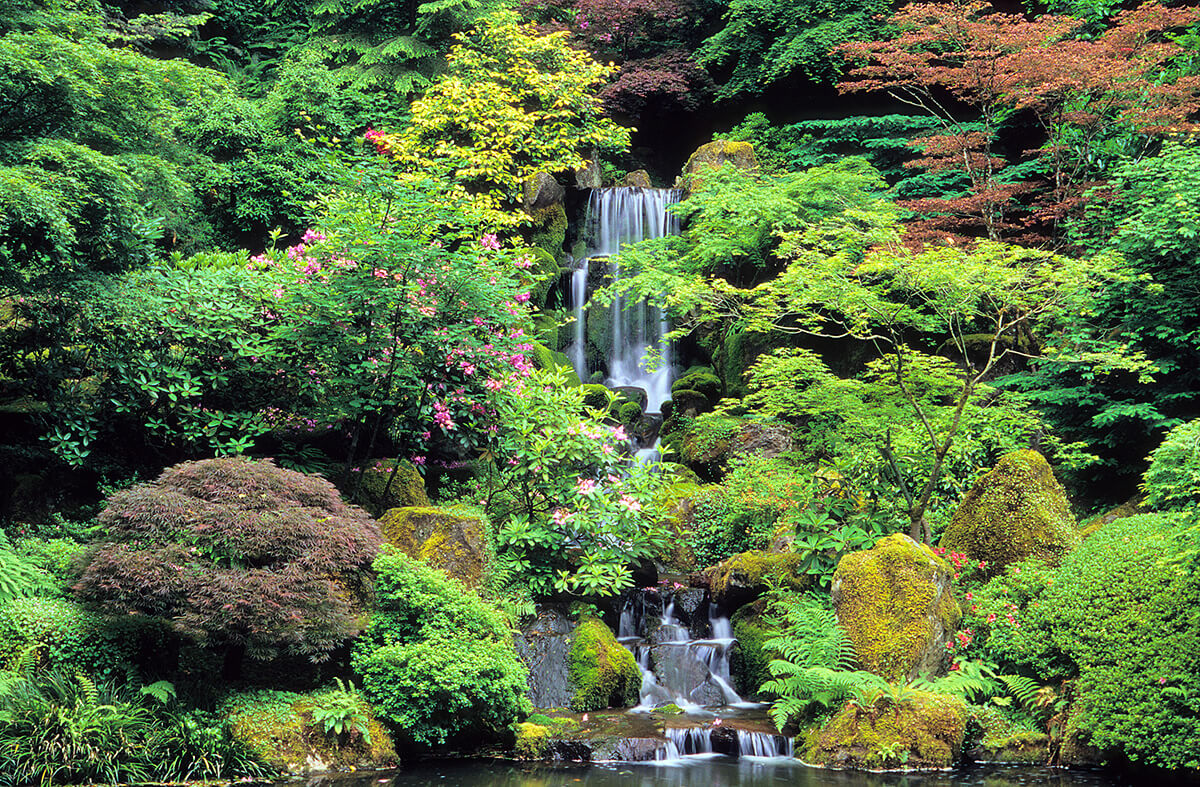
“Experiencing” Turns the Garden into a Special Existence
Bloom A garden is just a presence and cannot become a true “garden.” It is just plants, stones, and water. When people come and have a personal experience in the garden, that is when the garden first becomes a special and irreplaceable place to that individual. Then they become involved and create personal connections. Therefore, through the garden, we strive to create a sense of family (team, group, colleagues) with shared experiences. Dr. Kato, I see that you have begun to incorporate this at Keihanna Commemorative Park. I think it is a wonderful thing.
Kato This is the 10th year that Ueyakato Landscape Co., Ltd. has been designated by Kyoto Prefecture to manage and operate the Keihanna Commemorative Park. During this time the park director, Yamaguchi, has strived to create a “Japanese garden that is loved by the community.” Over the last 10-years, he has fostered the programming style and supporter groups we have today.
Yamaguchi 10-years ago, when we first started managing this garden, we decided to focus on 2 key points. First, was to create a Japanese garden where anyone can come and enjoy in their own style. We want more people to come with their babies, use a stroller, and people who use wheelchairs to enjoy the garden. We wanted people to appreciate the enjoyments of a Japanese garden in their own style, so it is alright for little children to energetically play or to eat lunch. Next was to spread the word. We have kept these two key points a priority.
Bloom That is very important. It is important in public management of a park to have a vision for the garden where various people can be involved, and to communicate that vision. It is essential for people to see that they “have a place” in the vision of the garden.
Yamaguchi Historically, Japanese gardens were only enjoyed by high society and the wealthy class for a long time. It was not until after WWII that Japanese gardens became more open to the public for citizens could enjoy. However, since society did not know about this world, it was difficult to understand how to enjoy the gardens. We may have the techniques and skills to foster the garden, but we are challenged by how to care for and grow a public garden. From meeting you, Mr. Bloom, we have learned so much from the Portland Japanese Garden. A new path has been opened from the wonderful stimulation we have received from you.
Bloom I think the Keihanna Commemorative Park can become a model for other gardens, other parks, and other organizations in Japan around adopting some of these ideas.
Yamaguchi We had over 190 programs year last year. We still have much to improve, but thankfully, the number of visitors to Suikei-en (pay area) is now around 80,000 visitors compared to the 30,000 visitor count when we first started managing the park. The overall visitors to Keihanna Commemorative Park went from 200,000 visitors to 600,000 visitors in the last 9-years.
Kato Your volunteer system is one aspect we hope to learn much about. The Portland Japanese Garden has a volunteer coordinator who operates the volunteer system wonderfully within the management of the Japanese garden. We strive to work closely with our volunteers at the Keihanna Commemorative Park, however our system is not as established as yours.
Yamaguchi Our park also has strong layer of volunteers, which we are greatly supported by. Currently, there we have 80 volunteers signed up, and between 20 to 30 of the volunteers are the core members. They also maintain the beauty of the forest and their contributions are so great, that the park would not function properly without these core members. The efficient systemization of the volunteer coordination, I feel, is quite a challenge.
Bloom In the USA, we have a cultural value of philanthropy based on our religious heritage. If you are successful in society, then you give back to the community, and that is how you truly become independent as a member of society. I think Japanese originally have big hearts capable of deep consideration, so the moral of giving back to the community is there. However, in recent years Japan’s values have leaned more towards economical success, efficiency, and self interest. Philanthropy and the spirit of noblesse oblige*3 cannot take root if it is not a mutual value held by society, which includes you and those around you to practice it.
Yamaguchi In Japan, starting with Kyoto, the relationship to locally support each other comes from the saying “okage-sama” (thanks to you) and “otagai-sama” (be in the same predicament) are common used between the citizens in a neighborhood. My grandmother was a person who helped and cleaned the local community without saying a word. Perhaps because of that value of modesty, our park has “silent volunteers” who pick up trash early in the morning and do not identify themselves.
Kato Even though there is a difference in religion and cultures, the spirit of selflessness is deeply rooted in the original values of Japanese culture. It is important to establish a system where our garden fans feel compelled to “want to support and eager to be involved” in working with us.
Bloom That is very true. When people receive a gift, they tend to give a gift back. In order to create a culture of the 21st century that values donation and reciprocity, I think it is important that we take the first step in showing a good example.
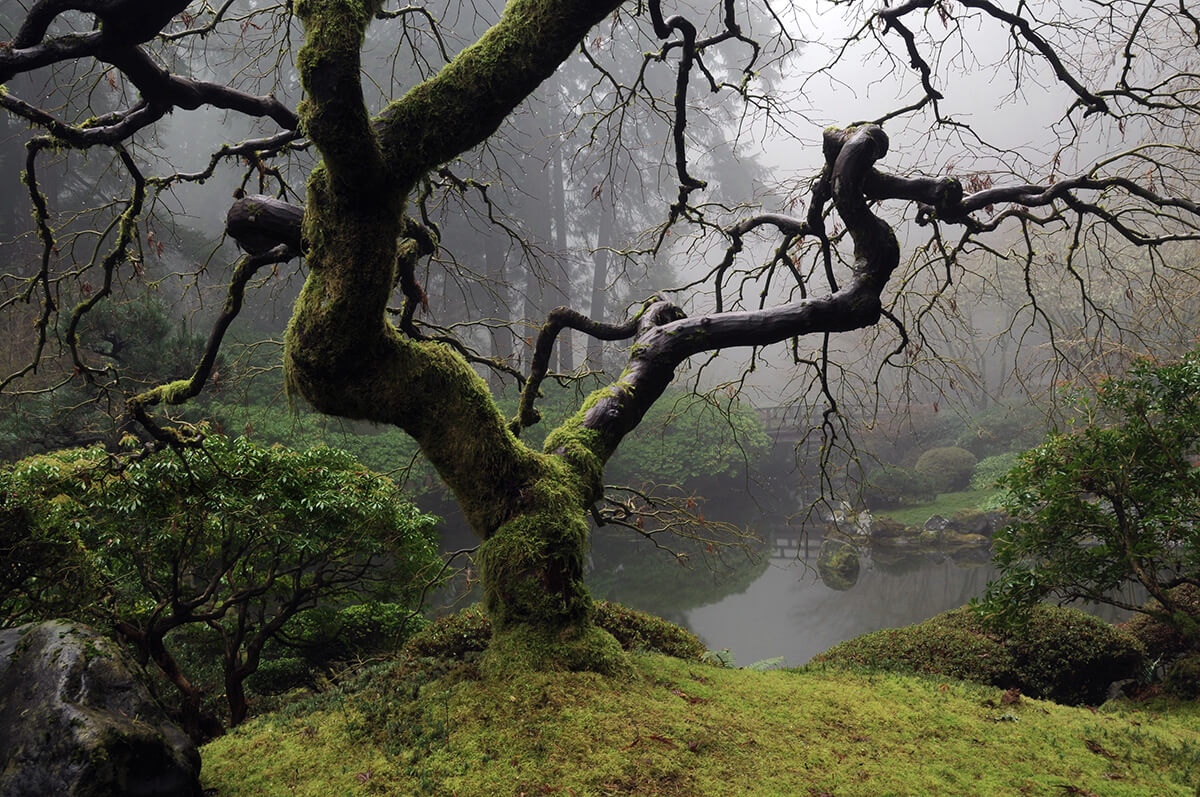
The Portland Japanese Garden has an environment where moss can grow because of similar climates as Japan. The trunk of the weeping maple is covered with moss, creating a refined aesthetic look.
Photo: Michel Hersen
Basing Japanese Gardens to the Local Scenic Landscape
Kato Mr. Bloom, what do you feel are the potentials and wonderful aspects of a Japanese garden?
Bloom There are common elements used in Japanese gardens that do not largely differ. Yet, each garden is very unique. When I view a Japanese garden, I try to find the distinguishing quality or unique value of that particular garden, which separates it from the others. This perspective is not a comparison of criticism, but rather to find the unique charm each garden has. This way of viewing a Japanese garden allows me to enjoy the depth and variety of this world.
Yamaguchi Japanese gardens are intentionally created to harmonize with and reflect the local scenery. Hence it creates the sense of “~esque” scenery.
Kato I was surprised when I first went to the Portland Japanese Garden. Large trees with heights of 70 to 80 meters surround the area. I had heard and seen pictures in advance too, yet I was overwhelmed when I stood there and experienced the sight.
Bloom Portland has a dynamic landscape with rolling hills and the types of trees are different from Japan. Despite the grandeur scenery, there are some similarities to Japan. I think the Portland Japanese Garden’s distinctive feature is the utilization of its’ unique landscape.
Yamaguchi The concept of harmony between people and nature is the base for Japanese gardens. I see that it does not change even for gardens abroad.
Bloom In addition, I believe Japanese gardens are a wonderful venue for learning. At first, I was impressed with the scenic beauty of the garden. As I learned more about this world, I came to realize that gardens are a fantastic educational platform. Starting with the techniques of garden craftsmen, Japanese culture, architecture, arts and crafts, to food, as well as science related topics, such as biology and environmental issues. We can also teach community engagement, volunteerism, philanthropy (noblesse oblige), human relationships, community organizing, and so much more through gardens.
Kato So all of these were considered in the operational method and event programming at the Portland Japanese Garden.
Bloom I cannot think of any other venue with as much opportunity for teaching that is as flexible as a garden.
Yamaguchi t is exactly as you say, gardens are able to catch various messages and in turn transmit them. We strive to do the same type of programming as you do.
Bloom For us, it is also important that we teach about diversity, because Portland is not a very diverse city. A Japanese garden gives people the opportunity to learn about another culture through physical and actual experiences. Hence a Japanese garden is a wonderful platform for teaching diversity.
Kato For those purposes, the garden needs to have “good hard aspects” or high quality physical investments. First, Professor Takuma Tono designed a wonderful garden 50-years ago for Portland Japanese Garden. After that, the continuation and improvement of the director system. These are hard aspects that are difficult to find, which has increased the tangible and intangible worth of the garden, as well as the ability to use the garden for multi-purposes.
Yamaguchi Quality programming and events require good hard aspects. We believe there are 4 main foundations concerning the maintenance and operation of a garden.
1) good hard aspects (tangible) -> 2) good soft aspects (intangible) -> 3) good advertisement -> 4) good relationships
I am certain that our park was able to grow because we started with good hard aspects, which allowed us to add good soft aspects (ex: services). It is our continued challenge to pursue what kind of an education venue the community needs from us, and to strive to be a park that is cherished by the community.
Bloom I think our potential future challenge is how to make the Keihanna Commemorative Park into a model garden for Japan and the Portland Japanese Garden into a model garden for America, and to consider how the world thinks of each of us and how we are being viewed.
Kato I believe this signing will help to transmit the recognition of the Portland Japanese Garden as an international success to the world, and prove to be an inspiration to Japanese gardens in Kyoto and throughout Japan.
Bloom There are 2 things we want to challenge ourselves. The first is to foster the sense of beauty, because we are not Japanese we do not have a native Japanese craftsman’s natural born instincts of Japanese sensibility, aesthetics, and design. We can learn the technical aspects, however we cannot gain the inherent Japanese sensibilities within the heart. So considering that, how can we teach people abroad the sensibility, in other words how do we foster the heart and spirit? In spring, we will launch the “International Institute for Japanese Garden Arts and Culture.” We hope to use this new facility to not only teach the technical aspects, but also elements of the Japanese heart and soul, through Japanese culture and sensibility.
Kato I look forward to it. What is the second challenge?
Bloom Creating a comprehensive technical training program. Currently if foreigners (those of us abroad) want to learn the technical aspect of Japanese gardening, the requirements are much too difficult because we have to learn Japanese, come to Japan, stay for 10-years or more, and pay for all expenses. Therefore, how can we compress 10-years worth of training that Japanese garden craftsmen do into a 2-year training course? If we can achieve this, it will be possible to disseminate knowledge not only at the Portland Japanese Garden, but throughout the 300 Japanese gardens in North America. If we are able to accomplish this, then we contribute to raising the standard quality of fostered Japanese gardens. So again, it is trying to take the Japanese garden craftsmen’s techniques and converting it into the context of an American training program. The goal is a “2-year program using English conducted in America.”
Kato That will be an amazing accomplished. Please let us know if there is anything we can do to assist you.
Bloom Thank you very much. We hope to disseminate what we learn from you to people who work for Japanese gardens throughout America and across the world. Transmitting this type of technical education is also under consideration and can be facilitated at the newly developed “International Institute for Japanese Garden Arts and Culture.”
Kato I believe there are some things that can only be noticed from a non-native point of view. In turn, to learn about the perspectives from different cultures will be a valuable lesson for us.
Bloom The Japanese gardens around the world are like children, where Japan is the parent. The children see things from a different perspective than the parent. The young minds of children are not yet affected by experience, hence there are some things our fresh perspectives and difference in approach can help evolve the thoughts of the parent.
Kato I totally agree with you.
Yamaguchi We have many things we want to learn from you in various fields. I look forward to continuing our wonderful relationship, and hope to further deepen each other’s knowledge.
Kato Let us each make the most of our strengths to foster a strong relationship of mutual learning. Thank you very much for your time today.
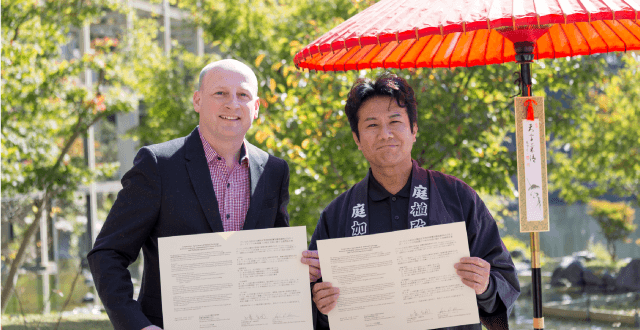
Commemorative signing between the Portland Japanese Garden × Ueyakato Landscape Co., Ltd.
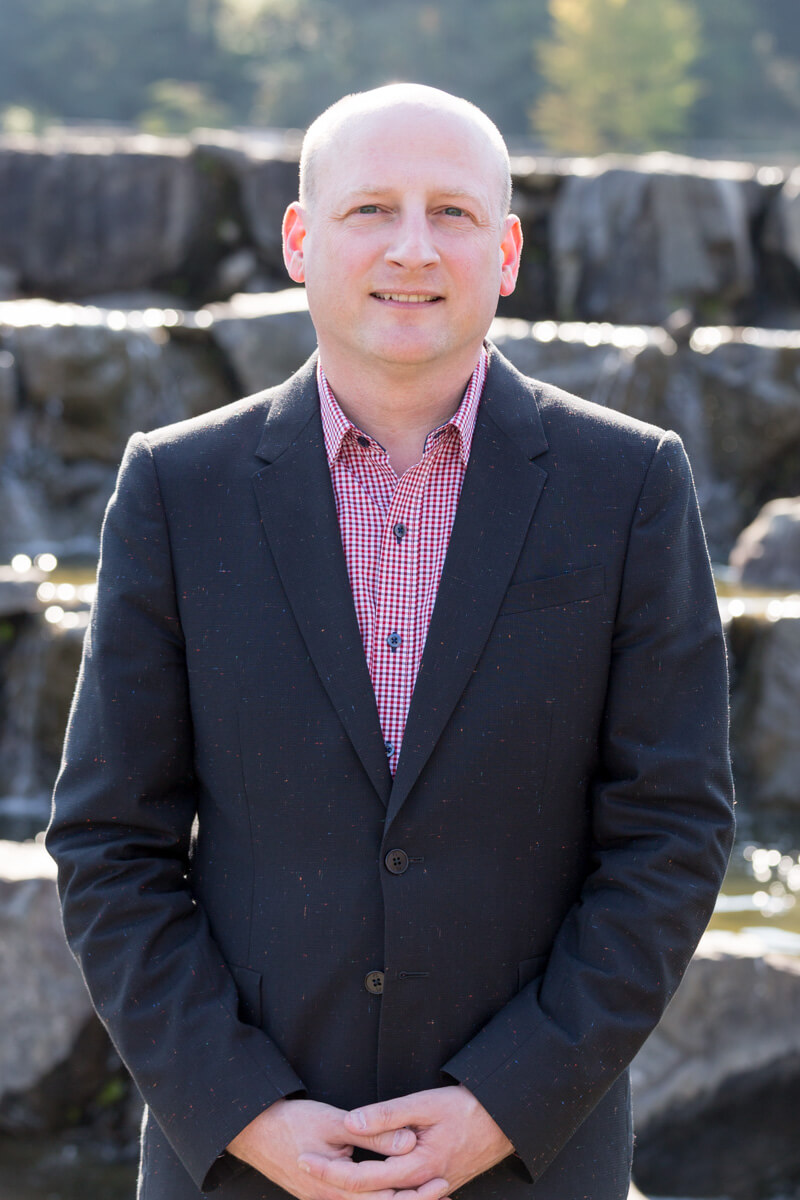
Stephen D. Bloom
Chief Executive Officer
Portland Japanese Garden
Profile
Chief Executive Officer of the Portland Japanese Garden since 2005, Steve Bloom’s background and experience lies in dynamic management and stewardship of diverse, complex, and exceptional non-profit organizations. Steve was a 2008-09 Council on Foreign Relations International Affairs Fellow in Japan, sponsored by Hitachi, Ltd. and concurrently served as Visiting Scholar at Tokyo University of Agriculture. Most recently he served as President of the Honolulu Symphony (2000-2005) and prior to Honolulu, showed early success at the age of 27 when he served as Executive Director of the Tacoma Symphony (1996-2000).
Steve received his Bachelor’s degree in Music Education in 1991 from the State University of New York’s Crane School of Music, and in 2003 was a recipient of a Social Innovation Fellowship to attend the Stanford University Graduate School of Business executive education program on non-profit management. He currently serves as a member of the Friends of the US–Japan Council in Washington D.C., Vice Chair of the Japan America Society of Oregon, Vice President of the Portland-Sapporo Sister City Association, and has served as founding President of the North American Japanese Garden Association Board of Directors, on the Board of Regents of Chaminade University Honolulu, as the President of the Washington State Arts Alliance, and as the Chairman of the Washington Park Alliance. Steve was the recipient of the 2013 Oregon Heritage Tourism Award given at the statewide Governor’s Conference on Tourism. In 2004, Steve was the recipient of the Pacific Business News “Forty under 40” award, recognizing young business leadership, and received a commendation from Hawaii Governor Linda Lingle for community service. Other professional positions have included employment with the Buffalo Philharmonic and the Sacramento Symphony.
October 16, 2015
Keihanna Commemorative Park
Photo: Yoshiyasu Nishikawa
Witter: Yoko Fukuda
Translated: Eureka Kobayashi
